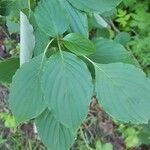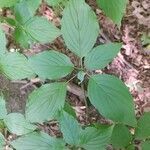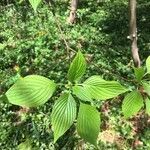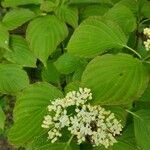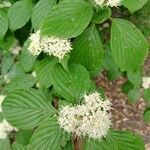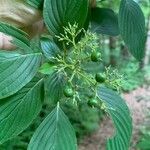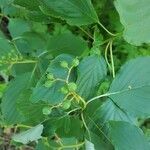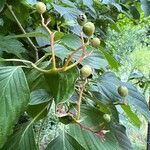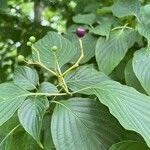Shrubs or trees, to 12 m, flowering at 2 m. Stems clustered; bark thick, corky, plates rectangular, 0.5–1 cm wide; branchlets usually green to yellowish green, sometimes reddish brown, glabrous; lenticels lenticular, then splitting periderm longitudinally. Leaves: petiole 20–50 mm; blade narrowly to broadly ovate or obovate, 4–12 × 2.3–7 cm, base usually cuneate, rarely rounded, apex abruptly acuminate or cuspidate, abaxial surface yellow-green, papillose, appressed-hairy, adaxial surface dark green, glabrate; secondary veins 5–6 per side, most arising from basal 1/2. Inflorescences flat to hemispheric, 3–15 cm diam., 50–100-flowered; peduncle 30–60 mm; branches and pedicels yellow-green, turning red in fruit, alternate on central axis, proximal 2–3 orders with minute bracts. Flowers: hypanthium appressed-hairy; sepals 0–0.2 mm; petals cream, 2.5–4 mm. Drupes blue, globose, 5–8 mm diam.; stone subglobose, laterally compressed, 5–6 × 5–6 × 4 mm, slightly ribbed. 2n = 20.
More
Shrub or small tree to 6 m, the twigs with white pith; lvs alternate, thin, ovate to oblong or obovate, 5–10 cm, conspicuously acuminate, pale green and minutely strigillose beneath, the lateral veins 4 or 5 on each side; petioles 8–50 mm, even on the same twig; infl usually hemispheric; sep very short or obsolete; fr blue; stone with a deep pit at the summit; 2n=20. Rich woods and thickets; Nf. and N.S. to Minn., s. to Fla., Ala., and Ark. May–July. (Svida a.)
Deciduous hardwood forests, usually mesic or dry-mesic, loamy soils, rocky slopes; at elevations from 10-2,000 metres. Rich woodlands and forest margins in moist well-drained soils.
